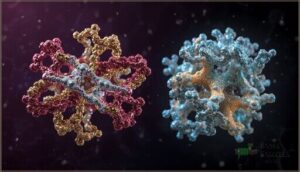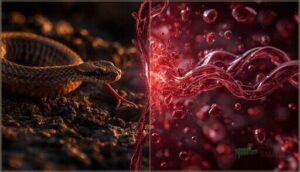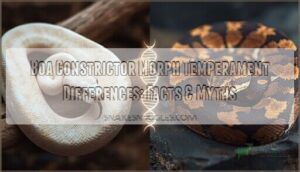This site is supported by our readers. We may earn a commission, at no cost to you, if you purchase through links.
When a brown snake strikes, its venom doesn’t just kill—it rewrites the rules of your blood’s clotting cascade. Eastern brown snake anticoagulants represent one of nature’s most paradoxical weapons: proteins that simultaneously trigger massive clot formation while dismantling your body’s ability to form stable clots.
Nearly 100% of severe envenomation cases develop consumption coagulopathy, with fibrinogen levels plummeting as the venom’s prothrombin activators hijack normal hemostasis. What makes these toxins particularly fascinating to hematologists isn’t their lethality—it’s their surgical precision in targeting specific coagulation factors.
Understanding how phospholipase A2 enzymes, metalloproteinases, and three-finger toxins disrupt thrombosis pathways has transformed both antivenom development and our fundamental knowledge of human coagulation disorders.
Table Of Contents
- Key Takeaways
- Eastern Brown Snake Venom and Hemostasis
- Anticoagulant Components in Eastern Brown Snake Venom
- Venom-Derived Enzymes Affecting Coagulation
- Clinical Implications of Eastern Brown Snake Anticoagulants
- Advances in Antivenom and Medical Treatment
- Frequently Asked Questions (FAQs)
- What are the anticoagulants in snake venom?
- What snakes have anticoagulants?
- Is brown snake venom an anticoagulant?
- Do snakes have anticoagulants in their saliva?
- Are there anticoagulant proteins from snake venom?
- Does brown snake venom have a presynaptic neurotoxin?
- Are there geographical variations in eastern brown snake anticoagulants?
- How fast does eastern brown venom clot blood?
- Can eastern brown anticoagulants be medically useful?
- What dosage causes anticoagulant effects in humans?
- Conclusion
Key Takeaways
- Eastern brown snake venom triggers a paradoxical coagulopathy where its prothrombin activators (pseutarin-C) cause explosive clot formation that rapidly depletes fibrinogen and clotting factors, leaving you with incoagulable blood in nearly 100% of severe envenomation cases.
- The venom’s anticoagulant components include five major protein families—phospholipase A2 enzymes, metalloproteinases, serine proteases, C-type lectins, and Kunitz inhibitors—each targeting distinct points in your coagulation cascade with surgical precision.
- Geographic variation significantly impacts clinical outcomes, as southern populations produce stable clots while northern snakes generate fragile, rapidly degrading clots, yet current antivenom uses pooled venom of unstated origin that may not adequately address region-specific toxin profiles.
- Beyond their lethality, these venom proteins have revolutionized hematology research and therapy development, transforming our understanding of coagulation pathways and enabling creation of precision diagnostic tools like the Snake Venom Detection Kit and novel anticoagulant therapies.
Eastern Brown Snake Venom and Hemostasis
Understanding how Eastern Brown Snake venom affects your blood’s clotting system is essential for recognizing the serious medical challenges these bites present. The venom’s complex biochemical makeup doesn’t just interfere with one part of hemostasis—it disrupts multiple pathways simultaneously, creating a cascade of coagulation problems that can quickly become life-threatening.
Let’s examine what makes this venom so potent, starting with its core composition, then moving through its specific effects on blood clotting, and finally exploring how venom characteristics change depending on where the snake lives.
Overview of Venom Composition
You’ll find that Eastern Brown Snake venom composition reveals striking biochemical complexity. Snake Venom Composition includes over 90% protein content dominated by specific Venom Protein Families:
- Phospholipase A2 enzymes and three-finger toxins exceed 60% of total venom mass
- Prothrombin activator complexes drive potent Coagulation Disorders through Hemostasis disruption
- Neurotoxins like textilotoxin constitute 3% by weight
- Glycoprotein Content features N-linked sugars including sialic acids
These Bioactive Molecules and Venom-derived enzymes demonstrate substantial Enzyme Diversity affecting multiple physiological systems. The study of venom potency variations is vital in understanding the complexity of Eastern Brown Snake venom.
Hemostatic Effects of Eastern Brown Snake Venom
When you encounter Eastern Brown Snake venom, you’re facing two potent venom proteins—a factor V variant and a factor Xa-like enzyme—that dominate 20–40% of the total composition. These form pseutarin-C, a calcium-dependent prothrombinase complex driving sustained thrombosis through prothrombin conversion. Don’t let the procoagulant mechanism fool you—this rapidly triggers consumption coagulopathy, depleting fibrinogen and disrupting hemostasis. One-third of victims develop severe hemorrhage, cardiovascular collapse, or thrombotic microangiopathy. Understanding the severe envenoming treatment is essential for effective management of the condition.
| Clinical Manifestation | Mechanism | Frequency |
|---|---|---|
| Consumption Coagulopathy | Fibrinogen depletion | Nearly 100% severe cases |
| Major Hemorrhage | Factor consumption | ~33% patients |
| Cardiovascular Collapse | Microangiopathy | ~33% patients |
| Prolonged Afibrinogenemia | Sustained venom activity | >11% beyond 24h |
This paradoxical combination—potent procoagulant activity producing anticoagulant effects—defines Eastern Brown Snake envenoming’s distinctive pathophysiology in coagulation disorders and anticoagulant therapy challenges.
Geographic Variation in Venom Properties
Geographic toxicology reveals striking regional venom differences across Eastern Brown Snake populations. Southern snakes produce sturdy, stable clots resembling taipan venom, while northern variants trigger fragile, rapidly degrading clots—a pattern driven by snake venom evolution and distinct venom protein variance.
These variations are characterized by the following:
- Southern populations express enhanced postsynaptic α-neurotoxins
- Queensland snakes show elevated presynaptic neurotoxin abundance
- Coagulation patterns diverge through unique factor X-like proteins
- Diet-driven evolution shapes venom composition regionally
- Genetic sequencing confirms population-specific prothrombin activator modifications
These variations complicate anticoagulant therapy protocols and antivenom efficacy.
Anticoagulant Components in Eastern Brown Snake Venom
While Eastern brown snake venom is notorious for its procoagulant effects, it also contains distinct anticoagulant components that work through different molecular pathways. These proteins are organized into specific families, each with unique structures and mechanisms that interfere with your body’s clotting cascade.
Understanding these anticoagulant elements helps explain why envenomation creates such complex coagulopathies and why treatment timing matters so much.
Protein Families With Anticoagulant Activity
You’ll recognize five major protein families in Eastern Brown Snake venom that drive anticoagulant effects: Phospholipase A2 enzymes, metalloproteinases, serine proteases, C-type lectins, and Kunitz inhibitors.
These venom-derived enzymes and inhibitors target distinct coagulation and thrombosis pathways—some act as thrombin inhibitors, others disrupt platelet function or degrade clotting factors.
Understanding these anticoagulants informs both anticoagulant therapy and treatment strategies for snakebite-induced coagulopathy.
Structure and Function of Key Anticoagulants
Structural precision defines how Eastern Brown Snake anticoagulants disrupt hemostasis. You’re looking at molecular architectures that evade normal coagulant regulation while driving rapid thrombin generation and prothrombin activation.
- Pseutarin-C forms a 280-kDa heterodimer with venom-derived factor V and Xa homologs, resisting activated protein C inactivation
- Textarin operates as a 230-kDa glycoprotein complex, bypassing factor Xa to activate prothrombin directly
- Venom proteomics reveal unique disulfide bonds stabilizing these venom-derived enzymes
- Anticoagulant design exploits these structures for therapeutic thrombin inhibitors
Mechanisms of Action on Coagulation Pathways
Dual disruption defines how these anticoagulants attack your coagulation cascade. Pseutarin-C drives explosive thrombin generation, depleting prothrombin and fibrinogen by 95% within hours—you’re left with incoagulable blood.
Eastern brown snake anticoagulants paradoxically trigger explosive clotting that consumes your body’s clotting factors, leaving you with incoagulable blood within hours
Meanwhile, CM-IV venom proteases simultaneously block tenase and prothrombinase complexes, creating cascade bottlenecks.
This paradoxical shift from hypercoagulation to consumption coagulopathy destroys hemostatic balance, impairing both platelet aggregation and fibrinolysis regulation.
Venom-Derived Enzymes Affecting Coagulation
Eastern brown snake venom contains several enzyme families that directly interfere with your blood’s clotting mechanisms. Each enzyme class targets specific points in the coagulation cascade, creating distinct anticoagulant effects that you’ll encounter in clinical practice.
Understanding these three major enzyme groups will help you recognize how venom components disrupt hemostasis at the molecular level.
Phospholipase A2 (PLA2) Anticoagulant Effects
You’ll find that phospholipase A2 in brown snake venom disrupts coagulation by targeting membrane-bound enzyme complexes essential for clotting. The anticoagulant mechanism hinges on enzyme structure—specifically, a catalytic histidine residue.
Therapeutic targeting with PLA2 inhibition shows promise: varespladib at micromolar concentrations neutralizes these venom-derived enzymes. Understanding this anticoagulant therapy pathway advances hematology research, potentially improving clinical applications in coagulation management and snakebite treatment protocols.
Metalloproteinases and Coagulation Inhibition
Metalloproteinases dominate eastern brown snake venom—comprising roughly 75% of proteinaceous toxins—and they don’t just accelerate coagulation; they dismantle it. Zinc-dependent enzymes cleave fibrinogen directly, triggering fibrinogenolysis that depletes clotting substrates. They rupture capillary basement membranes under blood flow, unleashing hemorrhage.
Metalloproteinase inhibitors like marimastat restore coagulation pathways at micromolar concentrations, offering targeted anticoagulant therapies for venom-induced coagulopathy in hematology practice.
Serine Proteinases and Protein C Activation
Serine proteinases in eastern brown snake venom activate protein C, flipping coagulation pathways from clot-building to clot-limiting. Pseutarin C enhances protein C activation over 1000-fold, mimicking mammalian factor V. This catalytic efficiency triggers anticoagulant effects at just 1 μg/mL in human plasma.
- Complete inhibition occurs within minutes of exposure
- Geographic variation alters enzyme activity by 25%
- Hemostasis disruption targets specific coagulation disorders
Clinical Implications of Eastern Brown Snake Anticoagulants
When Eastern Brown Snake venom enters your bloodstream, it doesn’t just create a medical emergency—it triggers a cascade of coagulation changes that challenge even experienced clinicians. Understanding how these anticoagulant components affect human hemostasis is essential for managing envenomation and recognizing their potential beyond the bedside.
Let’s examine three critical areas where these venom proteins intersect with clinical practice.
Effects on Human Coagulation and Thrombosis
When Eastern Brown Snake venom enters your bloodstream, it rapidly disrupts hemostatic balance through venom-derived enzymes that mimic natural coagulation factors. You’ll see fibrinogen plummet to 0.9 g/L while INR climbs to 1.7—a dangerous tipping point between thrombosis risks and hemorrhage.
Though coagulation disorders usually manifest as bleeding, geographic venom variations can paradoxically trigger substantial clot formation, complicating anticoagulant therapy and treatment decisions.
Venom-Induced Coagulopathy in Snakebite Victims
When you’re struck by an Eastern Brown Snake, venom-induced consumption coagulopathy (VICC) hits in 99% of cases—fibrinogen vanishes, INR soars beyond measurement limits, and clotting factors V, VIII, and X disappear within hours. Snakebite symptoms escalate fast: you’ll see mucosal bleeding, collapse within 20 minutes, even cardiac arrest. Blood clotting unravels completely, turning hemostasis regulation into chaos that demands immediate antivenom intervention.
Understanding VICC’s Clinical Patterns:
- Your coagulation disorders manifest through undetectable fibrinogen and prolonged prothrombin time, yet platelets often remain normal—distinguishing this from typical DIC
- Collapse occurs rapidly, with a median time of just 20 minutes from bite to cardiovascular compromise in severe envenomations
- Snake venom toxicity depletes clotting factors faster than your body can replenish them, requiring 12–18 hours post-antivenom for endogenous resynthesis
- Spontaneous hemorrhage from venepuncture sites or mucous membranes signals that venom-derived enzymes have overwhelmed your hemostatic mechanisms
- Early recognition transforms outcomes—delayed presentation prolongs coagulopathy and increases bleeding risk, while prompt anticoagulant therapy reversal saves lives
Diagnostic and Therapeutic Uses of Venom Proteins
Beyond managing snakebite crises, you’ll find venom proteins revolutionizing hematology research and therapy. Venom-derived enzymes undergo proteomic analysis and venom protein purification for diagnostic kit design—the Snake Venom Detection Kit identifies envenomation types from bite swabs, while therapeutic agent development leverages anticoagulant therapy principles.
Snake venom components now drive coagulation disorder treatment, transforming toxins into precision tools for hemostasis investigation and novel anticoagulant therapy development.
Advances in Antivenom and Medical Treatment
When you face an Eastern Brown Snake bite, the antivenom you receive can mean the difference between recovery and serious complications. Current treatment protocols rely on standardized antivenom products, but emerging research reveals significant challenges tied to geographic venom variation.
Understanding these advances helps you grasp why precision toxicology represents the next frontier in snakebite management.
Efficacy of Current Brown Snake Antivenom
You’ll find that brown snake antivenom demonstrates impressive clinical efficacy, achieving 100% survival in prospective studies of envenomed patients. Coagulation recovery usually occurs within 4.6 to 9.5 hours, depending on adjunct therapy.
Hypersensitivity reactions remain relatively uncommon at 10%, and snakebite outcomes consistently improve with prompt administration, though venom variability may influence antivenom potency across different regions.
Geographic Variation and Antivenom Challenges
You might think uniform antivenom coverage protects across Australia, but venom variation within eastern brown snakes tells a different story. Southern populations produce firm, stable clots, while northern venoms create fragile ones that collapse quickly.
Current antivenom uses pooled venom of unstated origin, potentially compromising antivenom efficacy against region-specific toxins. Snake venom research now reveals these regional risks directly impact snakebite outcomes, demanding geographic awareness in treatment protocols.
Future Directions in Precision Toxicology
How will precision medicine reshape snakebite management? Toxicology research now prioritizes biomarker discovery to match antivenoms with regional venom profiles, aiming for tailored treatment that tackles coagulopathy with unmatched accuracy.
- AI-driven venom genomics accelerates discovery of venom-derived enzymes and inhibitors for antivenom development
- Monoclonal antibody diagnostics target population-specific toxins with >95% sensitivity in preclinical validation
- Clotting pattern analyses guide anticoagulant therapy and treatment selection through predictive analytics
- Venom biobanks containing over 1,000 specimens support comparative toxinology research and thrombosis and hemostasis studies
- Clinical decision tools integrate real-world data to refine protocol compliance above 90%
Frequently Asked Questions (FAQs)
What are the anticoagulants in snake venom?
Snake venom contains anticoagulant proteins, including phospholipase A2 enzymes, metalloproteinases, and serine proteinases.
These venom-derived enzymes and inhibitors disrupt hemostasis regulation by degrading coagulation factors, inhibiting complex assembly, and activating natural anticoagulant pathways.
What snakes have anticoagulants?
You’ll encounter anticoagulant snake species worldwide—African spitting cobras, Australian black snakes, blunt-nosed vipers, and saw-scaled vipers.
All disrupt your coagulation pathways through venom-derived enzymes like PLA2 metalloproteinases, affecting blood clotting mechanisms.
Is brown snake venom an anticoagulant?
Brown snake venom isn’t purely an anticoagulant—it’s chiefly procoagulant, triggering disseminated intravascular coagulation. However, you’ll find anticoagulant components like phospholipase A2 within the venom, creating complex hemostasis regulation challenges requiring targeted snakebite treatment strategies.
Do snakes have anticoagulants in their saliva?
While venom delivery evolved specialized anticoagulant origins through salivary proteins, true saliva composition in most snakes lacks clinically significant anticoagulants.
Venom-derived enzymes and inhibitors affecting blood coagulation disorders remain primarily gland-specific, not saliva-based.
Are there anticoagulant proteins from snake venom?
Yes, anticoagulant proteins from snake venom exist across multiple species. High-throughput screening identified previously unreported anticoagulant toxins, including C-type lectins and phospholipase A2 families, which inhibit specific coagulation factors and prolong clotting times.
Does brown snake venom have a presynaptic neurotoxin?
Textilotoxin is the primary presynaptic neurotoxin in eastern brown snakes. However, its low abundance (3–7% of venom composition) and limited potency explain why neurotoxicity mechanisms rarely dominate snakebite symptoms. This results in less antivenom adjustment being required compared to coagulopathy.
Are there geographical variations in eastern brown snake anticoagulants?
Significant geographic variance exists within Pseudonaja textilis populations. Regional adaptation drives anticoagulant mechanisms: northern snakes produce rapid-acting but fragile clots, while southern populations generate stable clots, affecting snakebite outcomes and anticoagulant therapy considerations.
How fast does eastern brown venom clot blood?
In laboratory conditions, Eastern Brown Snake venom initiates clot formation in plasma samples within 2–7 seconds—lightning-fast compared to normal human coagulation, which takes 6–10 minutes.
This rapid process triggers immediate hemostasis disruption and rapid thrombin activation, showcasing the venom’s potent effects on coagulation pathways.
Can eastern brown anticoagulants be medically useful?
You’ll find that venom-derived enzymes and inhibitors show exceptional therapeutic applications in anticoagulant therapy and treatment.
Medical research is advancing drug development through clinical trials targeting coagulation disorders using snake venom hematology products.
What dosage causes anticoagulant effects in humans?
Your blood coagulation faces disruption at vanishingly small venom potency levels—as low as 15 ng/mL in plasma triggers anticoagulant effects.
The toxic dose response shows coagulopathy develops in 99% of envenomations, establishing an extraordinarily low anticoagulant threshold.
Conclusion
Eastern brown snake anticoagulants function like molecular locksmiths—picking apart your hemostatic machinery with astonishing specificity. While these toxins remain a clinical challenge in envenomation cases, they’ve unlocked critical insights into coagulation pathways and therapeutic targets.
Your understanding of prothrombin activators, PLA2 mechanisms, and consumption coagulopathy isn’t just academic—it’s essential for recognizing venom-induced bleeding disorders and advancing precision treatments. The venom that dismantles clotting has paradoxically taught us how to restore it.
- https://www.sciencedirect.com/science/article/pii/0041010194903522
- https://pubmed.ncbi.nlm.nih.gov/12362232/
- https://journals.plos.org/plosone/article?id=10.1371%2Fjournal.pone.0063988
- https://www.mja.com.au/journal/2025/222/6/early-cardiovascular-collapse-after-envenoming-snakes-australia-2005-2020
- https://litfl.com/does-antivenom-work/













